Mineralization of MVT Pb-Zn Deposits in the Process of Hydrocarbon Accumulation and Destruction in the Strong Structural Deformation Area of Eastern Sichuan, South China
Abstract
:1. Introduction
2. Geological Background and MVT Deposits
2.1. Geological Background
2.2. Ore Geology
3. Methods
4. Results
4.1. Fluid Inclusions
4.1.1. Fluid Inclusion Petrography
4.1.2. Raman Spectral Analytical Results of Fluid Inclusions
4.1.3. Fluid Inclusion Microthermometry and Trapping Pressure of Methane Inclusions
| Lead–Zinc Mine Name | Lead–Zinc Orebody Name | Sample | Host Mineral | FIA | Th (Range and Mean)/(°C) | Measured Number of Aqueous Inclusion | Tm/(°C) | Salinity/ (wt.% NaCl Equivalent) | |
|---|---|---|---|---|---|---|---|---|---|
| Laochangping | Liuhuangdong | SH1 | Sphalerite | FIA-1 | 141.2–158.8 | 150.1 | 4 | ||
| FIA-2 | 142.3–151.5 | 145.9 | 4 | −11.8~−9.8 | 13.72–15.76 | ||||
| FIA-3 | 151.2–155.8 | 153.5 | 3 | −13.4~−10.1 | 14.04–17.26 | ||||
| FIA-4 | 164.7–179.6 | 172.0 | 3 | ||||||
| Calcite | FIA-1 | 169.4–177.4 | 173.4 | 2 | |||||
| FIA-2 | 179.2–192.8 | 185.9 | 4 | −6.6~−6.1 | 9.34–9.98 | ||||
| FIA-3 | 181.2–199.5 | 191.1 | 5 | ||||||
| FIA-4 | 182.2–200.6 | 193.4 | 4 | −10.4~−7.6 | 11.22–14.36 | ||||
| FIA-5 | 193.7–203.6 | 198.5 | 3 | ||||||
| SH2 | Calcite | FIA-1 | 137.4–156.7 | 148.8 | 6 | −9.6~−7.9 | 11.58–13.51 | ||
| FIA-2 | 130.6–148.6 | 136.6 | 4 | ||||||
| FIA-3 | 140.0–152.9 | 145.9 | 4 | −12.4~−8.9 | 12.73–16.34 | ||||
| FIA-4 | 166.5–176.2 | 171.4 | 2 | ||||||
| Luota | Laoxi | LX2 | Sphalerite | FIA-1 | 97.7–126.3 | 107.7 | 4 | −12.4 | 16.34 |
| FIA-2 | 100.2–124.3 | 114.5 | 3 | ||||||
| FIA-3 | 112.6–123.9 | 117.0 | 4 | −17.0~−14.9 | 18.55–20.22 | ||||
| FIA-4 | 114.0–129.8 | 120.6 | 3 | ||||||
| FIA-5 | 131.1–133.3 | 132.5 | 3 | −16.4 | 19.76 | ||||
| FIA-6 | 142.5–155.5 | 149.0 | 2 | ||||||
| FIA-7 | 168.8–177.8 | 173.3 | 2 | −16.9~−9.6 | 13.51–20.15 | ||||
| Calcite | FIA-1 | 128.3–135.9 | 131.5 | 4 | −17.8~−14.1 | 17.87–20.82 | |||
| FIA-2 | 140.6–155.9 | 147.4 | 4 | ||||||
| Wujiahe | SZ2 | Fluorite | FIA-1 | 108.2 | 108.2 | 1 | |||
| FIA-2 | 137.5–143.2 | 139.8 | 3 | −12.1~−11.3 | 15.27–16.05 | ||||
| FIA-3 | 158.5–173.9 | 163.5 | 5 | ||||||
| FIA-4 | 181.7–192.4 | 187.1 | 2 | −7.6~−4.6 | 7.31–11.22 | ||||
| SZ3 | Sphalerite | FIA-1 | 101.2–117.3 | 109.3 | 2 | ||||
| FIA-2 | 121.4–134.6 | 127.9 | 4 | −18.6 | 21.4 | ||||
| FIA-3 | 127.6–134.8 | 130.7 | 3 | ||||||
| FIA-4 | 144.2–161.6 | 151.3 | 3 | −16.4~−21.5 | 19.76–23.37 | ||||
| Fluorite | FIA-1 | 93.2–106.5 | 98.8 | 3 | |||||
| FIA-2 | 127.6–136.5 | 131.5 | 5 | −12.1~−10.9 | 14.87–16.05 | ||||
| FIA-3 | 144.6–153.4 | 148.3 | 4 | ||||||
| FIA-4 | 153.2–158.4 | 156.8 | 4 | −12.4~−11.3 | 15.27–16.34 | ||||
| FIA-5 | 162.3 | 162.3 | 1 | −12.5 | 16.43 | ||||
| SZ4 | Sphalerite | FIA-1 | 93.2–118.6 | 105.9 | 2 | ||||
| FIA-2 | 121.7–133.8 | 127.6 | 3 | −17.6 | 20.67 | ||||
| Fluorite | FIA-1 | 93.7–106.8 | 101.7 | 3 | −13.5~−8.9 | 12.73–17.34 | |||
| FIA-2 | 96.2~109.6 | 104.4 | 4 | −7.7 | 11.34 | ||||
| FIA-3 | 114.3–118.6 | 116.45 | 2 | −15.2 | 18.8 | ||||
| FIA-4 | 130.8–164.4 | 146.1 | 5 | −6.1 | 9.34 | ||||
| FIA-5 | 162.3–167.1 | 164.7 | 6 | −12.1~−8.9 | 12.73–16.05 | ||||
| FIA-6 | 174.8–188.4 | 181.6 | 2 | ||||||
4.2. Rb-Sr and Sm-Nd Geochronology of the MVT Pb-Zn Deposits
4.2.1. Rb-Sr Isochron Ages of the Laochangping Pb-Zn Deposits
4.2.2. Rb-Sr Isochron Age of the Liaoxi Orebody
4.2.3. Sm-Nd Isochron Age and Sr Isotopic Compositions of the Wujiahe Orebody
5. Discussion
5.1. Possible Sources of Ore-Forming Fluids
5.2. Timing of MVT Pb-Zn Deposits Mineralization
5.3. Implication for MVT Mineralization Model around the Margin of the Eastern Sichuan Basin
6. Conclusions
Author Contributions
Funding
Data Availability Statement
Acknowledgments
Conflicts of Interest
References
- Gize, A.P.; Barnes, H.L. The organic geochemistry of two Mississippi Valley-type lead-zinc deposits. Econ. Geol. 1987, 82, 457–470. [Google Scholar] [CrossRef]
- Kesler, S.E.; Jones, H.D.; Furman, F.C.; Sassen, R.; Anderson, W.H.; Kyle, J.R. Role of crude oil in the genesis of Mississippi Valley-type deposits: Evidence from the Cincinnati Arch. Geology 1994, 22, 609–612. [Google Scholar] [CrossRef]
- Wu, Y.; Zhang, C.; Mao, J.; Ouyang, H.; Sun, J. The genetic relationship between hydrocarbon systems and Mississippi Valley-type Zn–Pb deposits along the SW margin of Sichuan Basin, China. Int. Geol. Rev. 2013, 55, 941–957. [Google Scholar] [CrossRef]
- Gao, J.; Li, Y.; He, S.; He, Z.; Li, S.; Wo, Y.; Li, W.; Zhai, G.; Zhao, J. Exploration Discovery of Shale Gas and Its Indicative Significance to Mineralization of MVT Lead-Zinc Deposit in Yichang Area, West Hubei. Earth Sci. 2021, 46, 1222–1232, (in Chinese with English abstract). [Google Scholar]
- Anderson, G.M. Precipitation of Mississippi Valley-type ores. Econ. Geol. 1975, 70, 937–942. [Google Scholar] [CrossRef]
- Anderson, G.M. Organic maturation and ore precipitation in Southeast Missouri. Econ. Geol. 1991, 86, 909–926. [Google Scholar] [CrossRef]
- Cai, C.F.; Worden, R.H.; Bottrell, S.H.; Wang, L.S.; Yang, C.C. Thermochemical sulphate reduction and the generation of hydrogen sulphide and thiols (mercaptans) in Triassic carbonate reservoirs from the Sichuan Basin, China. Chem. Geol. 2003, 202, 39–57. [Google Scholar] [CrossRef]
- Leach, D.L.; Sangster, D.F.; Kelley, K.D.; Large, R.R.; Garven, G.; Allen, C.R.; Gutzmer, J.; Walters, S. Sediment-Hosted Lead–Zinc Deposits: A Global Perspective. One Hundredth Anniversary Volume; Society of Economic Geologists: Littleton, CO, USA, 2005; pp. 561–608. [Google Scholar]
- Zhang, C.Q.; Wu, Y.; Hou, L.; Mao, J.W. Geodynamic setting of mineralization of Mississippi Valley-type deposits in world-class Sichuan–Yunnan–Guizhou Zn–Pb triangle, southwest China: Implications from age-dating studies in the past decade and the Sm–Nd age of Jinshachang deposit. J. Asian Earth Sci. 2015, 103, 103–114. [Google Scholar] [CrossRef]
- Xiong, S.; Jiang, S.; Ma, Y.; Liu, T.; Zhao, K.; Jiang, M.; Zhao, H. Ore genesis of Kongxigou and Nanmushu Zn-Pb deposits hosted in Neoproterozoic carbonates, Yangtze Block, SW China: Constraints from sulfide chemistry, fluid inclusions, and in situ S-Pb isotope analyses. Precambrian Res. 2019, 333, 105405. [Google Scholar] [CrossRef]
- Powell, T.G.; Macqueen, R.W. Precipitation of sulfide ores and organic matter sulfate reactions at Pine Point, Canada. Science 1984, 224, 63–66. [Google Scholar] [CrossRef]
- Xiong, S.; Gong, Y.; Jiang, S.; Zhang, X.; Li, Q.; Zeng, G. Ore genesis of the Wusihe carbonate-hosted Zn-Pb deposit in the Dadu River Valley district, Yangtze Block, SW China: Evidence from ore geology, S-Pb isotopes, and sphalerite Rb-Sr dating. Miner. Depos. 2018, 53, 967–979. [Google Scholar] [CrossRef]
- Xiong, S.; Jiang, S.; Chen, Z.; Zhao, J.; Ma, Y.; Zhang, D.; Duan, Z.; Niu, P.; Xu, Y. A Mississippi Valley–type Zn-Pb mineralizing system in South China constrained by in situ U-Pb dating of carbonates and barite and in situ S-Sr-Pb isotopes. Geol. Soc. Am. Bull. 2022. [Google Scholar] [CrossRef]
- Xu, J.; Zheng, Y.; Sun, X.; Shen, Y. Alteration and mineralization at the Zhibula Cu skarn deposit, Gangdese belt, Tibet. Ore Geol. Rev. 2016, 75, 304–326. [Google Scholar] [CrossRef]
- Xu, J.; Zheng, Y.; Sun, X.; Li, X.; Mao, G. Genesis of the Yaguila Pb-Zn-Ag-Mo skarn deposit in Tibet: Insights from geochronology, geochemistry, and fluid inclusions. J. Asian Earth Sci. 2019, 172, 83–100. [Google Scholar] [CrossRef]
- Rui, Z.Y.; Ye, J.H.; Zhang, L.S.; Mei, Y.X. Pb⁃Zn Deposits on the Perimeter of the Yangtze Craton and on the Margins of Its Uplifts. Geol. China 2004, 31, 337–346, (in Chinese with English abstract). [Google Scholar]
- Zhou, J.; Huang, Z.; Zhou, M.; Li, X.; Jin, J. Constraints of C–O–S–Pb isotope compositions and Rb–Sr isotopic age on the origin of the Tianqiao carbonate-hosted Pb-Zn deposit, SW China. Ore Geol. Rev. 2013, 53, 77–92. [Google Scholar] [CrossRef]
- Wang, H.; Ye, L.; Hu, Y.; Wei, C.; Li, Z.; Huang, Z.; Shuang, Y. Trace element characteristics in sphalerites from the Laochangping Pb-Zn deposit in the Southeastern Chongqing. Acta Mineral. Sin. 2021, 41, 623–634, (in Chinese with English abstract). [Google Scholar]
- Li, S.; Li, Y.; He, Z.; Chen, K.; Yan, D. Differential Deformation on Two Sides of Qiyueshan Fault along the Eastern Margin of Sichuan Basin, China, and Its Influence on Shale Gas Preservation. Mar. Petrol. Geol. 2020, 121, 104602. [Google Scholar] [CrossRef]
- Yan, D.; Bing, Z.; Zhou, M.F.; Wei, G.; Song, H.L.; Liu, S.F. Constraints on the Depth, Geometry and Kinematics of Blind Detachment Faults Provided by Fault-Propagation Folds: An Example from the Mesozoic Fold Belt of South China. J. Struct. Geol. 2009, 31, 150–162. [Google Scholar] [CrossRef]
- He, Z.L.; Wang, X.; Li, S.; Wo, Y.; Zhou, Y. Yanshan Movement and its influence on petroleum preservation in middle-upper Yangtze region. Pet. Geol. Exp. 2011, 33, 1–11. [Google Scholar]
- Yan, D.; Zhou, M.; Song, H.; Wang, X.; Malpas, J. Origin and tectonic significance of a Mesozoic multi-layer over-thrust system within the Yangtze block (South China). Tectonophysics 2003, 361, 239–254. [Google Scholar] [CrossRef]
- Fan, Y. Interrelationship between Tectonism and Hydrocarbon Accumulation in Marine Strata at Critical Tectonic Moment in West Hubei–East Chongqing, South China; China University of Geosciences: Wuhan, China, 2016; pp. 45–66, (in Chinese with English abstract). [Google Scholar]
- Ma, Y.S.; Lou, Z.H.; Guo, T.L.; Fu, X.Y.; Jin, A.M. An Exploration on a Technological System of Petroleum Preservation Evaluation for Marine Strata in South China. Acta Geol. Sin. 2006, 80, 406–417, (in Chinese with English abstract). [Google Scholar]
- Zhang, C.Q. The Genetic Model of Mississippi Valley-type Deposits in the Boundary Area of Sichuan, Yunnan and Guizhou Province, China; Chinese Academy of Geological Sciences: Beijing, China, 2008; pp. 1–177, (in Chinese with English abstract). [Google Scholar]
- Peng, N.L.; Liang, E.Y.; Liu, W.; Liu, G.Y.; Yuan, F.; Xiong, M.; Huang, L.Q.; Wang, Y.C. A comparative study of Luota Ore Field Lead-zinc Deposits in the Northwest of Hunan Province with Typical MVT Lead-zinc Deposits. South Met. 2014, 04, 5–16, (in Chinese with English abstract). [Google Scholar]
- Goldstein, R.H.; Reynolds, T.J. Systematics of fluid inclusions in diagenetic minerals. SEPM Short Course 31. Soc. Sediment. Geol. 1994, 199. [Google Scholar] [CrossRef]
- Gao, J.; He, S.; Yi, J. Discovery of high density methane inclusions in Jiaoshiba shale gas field and its significance. Oil Gas Geol. 2015, 36, 472–480, (in Chinese with English abstract). [Google Scholar]
- Gao, J.; He, S.; Zhao, J.X.; Yi, J. Geothermometry and geobarometry of overpressured Lower Paleozoic gas shales in the Jiaoshiba field, central China: Insight from fluid inclusions in fracture cements. Mar. Petrol. Geol. 2017, 83, 124–139. [Google Scholar] [CrossRef] [Green Version]
- Gao, J.; Zhang, J.; He, S.; Zhao, J.; He, Z.; Wo, Y.; Feng, Y.; Li, W. Overpressure generation and evolution in Lower Paleozoic gas shales of the Jiaoshiba region, China: Implications for shale gas accumulation. Mar. Petrol. Geol. 2019, 102, 844–859. [Google Scholar] [CrossRef]
- Lin, F.; Bodnar, R.; Becker, S. Experimental determination of the Raman CH4 symmetric stretching (ν1) band position from 1–650 bar and 0.3-22 °C: Application to fluid inclusion studies. Geochem. Cosmochim. Acta 2007, 71, 3746–3756. [Google Scholar] [CrossRef]
- Lu, W.; Chou, I.; Burruss, R.; Song, Y. A unified equation for calculating methane vapor pressures in the CH4-H2O system with measured Raman shifts. Geochim. Cosmochim. Acta 2017, 71, 3969–3978. [Google Scholar] [CrossRef]
- Wang, Y.X.; Gu, L.X.; Zhang, Z.Z.; Wu, C.Z.; Zhang, K.J.; Li, H.M.; Yang, J.D. Gerchronology and Nd–Sr–Pb isotopes of the bimodal volcanic rocks of the Bogda rift. Acta Petrol. Sin. 2006, 22, 1215–1224, (in Chinese with English abstract). [Google Scholar]
- Wopenka, B.; Pasteris, J.D.; Freeman, J.J. Analysis of individual fluid inclusions by Fourier transform infrared and Raman microspectroscopy. Geochem. Cosmochim. Acta 1990, 54, 519–533. [Google Scholar] [CrossRef]
- Bodnar, R. Revised equation and table for determining the freezing point depression of H2O-NaCl solutions. Geochem. Cosmochim. Acta 1993, 57, 683–684. [Google Scholar] [CrossRef]
- Duan, Z.; Møller, N.; Weare, J.H. An equation of state for the CH4-CO2-H2O system: I. Pure systems from 0 to 1000 °C and 0 to 8000 bar. Geochem. Cosmochim. Acta 1992, 56, 2605–2617. [Google Scholar] [CrossRef]
- Sallet, R.; Moritz, R.; Fontignie, D. Fluorite 87Sr/86Sr and REE constraints on fluid–melt relations, crystallization time span and bulk DSr of evolved highsilica granites. Tabuleiro granites, Santa Catarina, Brazil. Chem. Geol. 2000, 164, 81–92. [Google Scholar] [CrossRef]
- Stein, M.; Starinsky, A.; Agnon, A.; Katz, A.; Raab, M.; Spiro, B.; Zak, I. The impact of brine-rock interaction during marine evaporite formation on the isotopic Sr record in the oceans: Evidence from Mt. Sedom, Israel: Geochem. Cosmochim. Acta 2000, 64, 2039–2053. [Google Scholar] [CrossRef]
- Liu, W.H.; Zhang, X.J.; Zhang, J.; Jiang, M.R. Sphalerite Rb-Sr dating and in situ sulfur isotope analysis of the Daliangzi lead-zinc deposit in Sichuan Province, SW China. J. Earth. Sci 2018, 29, 573–586. [Google Scholar] [CrossRef]
- Zindler, A.; Hart, S.R.; Frey, F.A.; Jakobsson, S.P. Nd and Sr isotope ratios and rare earth element abundances in Reykjanes Peninsula basalts evidence for mantle heterogeneity beneath Iceland. Earth Planet. Sci. Lett. 1979, 45, 249–262. [Google Scholar] [CrossRef]
- Menzies, M.; Murthy, V.R. Nd and Sr isotope geochemistry of hydrous mantle nodules and their host alkali basalts: Implications for local heterogeneities in metasomatically veined mantle. Earth Planet. Sci. Lett. 1980, 46, 323–334. [Google Scholar] [CrossRef]
- Qi, L.; Zhou, M.F. Platinum-group elemental and Sr–Nd–Os isotopic geochemistry of Permian Emeishan flood basalts in Guizhou Province, SW China. Chem. Geol. 2008, 248, 83–103. [Google Scholar] [CrossRef]
- Veizer, J.; Ala, D.; Azmy, K.; Bruckschen, P.; Buhl, D.; Bruhn, F.; Carden, G.A.F.; Diener, A.; Ebneth, S.; Godderis, Y. 87Sr/86Sr, δ13C and δ18O evolution of Phanerozoic seawater. Chem. Geol. 1999, 161, 59–88. [Google Scholar] [CrossRef] [Green Version]
- Schneider, J.; Boni, M.; Lapponi, F.; Bechstädt, T. Carbonate-Hosted Zinc-Lead Deposits in the Lower Cambrian of Hunan, South China: A Radiogenic (Pb, Sr) Isotope Study. Econ. Geol. 2002, 97, 1815–1827. [Google Scholar] [CrossRef]
- Sawaki, Y.; Ohno, T.; Tahata, M.; Komiya, T.; Hirata, T.; Maruyama, S.; Windley, B.; Han, J.; Shu, D.; Lie, Y. The Ediacaran Radiogenic Sr Isotope Excursion in the Doushantuo Formation in the Three Gorges Area, South China. Precambrian Res. 2010, 176, 46–64. [Google Scholar] [CrossRef]
- Hu, R.; Wang, W.; Li, S.Q.; Yang, Y.Z.; Chen, F.K. Sedimentary Environment of Ediacaran Sequences of South China: Trace Element and Sr-Nd Isotope Constraints. J. Geol. 2016, 124, 769–789. [Google Scholar] [CrossRef]
- Liu, J.M.; Zhan, S.R.; Shen, J.; Jiang, N.; Huo, W.G. Review on direct isotopic dating of hydrothermal ore-forming processes. Prog. Geophys. 1998, 13, 46–55, (in Chinese with English abstract). [Google Scholar]
- Jin, Z.J.; Yuan, Y.S.; Liu, Q.Y.; Wo, Y.J. Controls of Late Jurassic-Early Cretaceous Tectonic Event on Source Rocks and Seals in Marine Sequences, South China. Sci. China Earth Sci. 2012, 42(12), 1791–1801. [Google Scholar] [CrossRef]
- He, Z.L.; Li, S.J.; Wo, Y.J.; Zhang, D.W.; Gu, Y.; Zhou, Y. Major Factors Controlling Hydrocarbon Preservation Condition in the Marine Basins of China and its Evaluation Ideas. Acta Petrol. Sin. 2017, 33, 1222–1232, (in Chinese with English abstract). [Google Scholar]

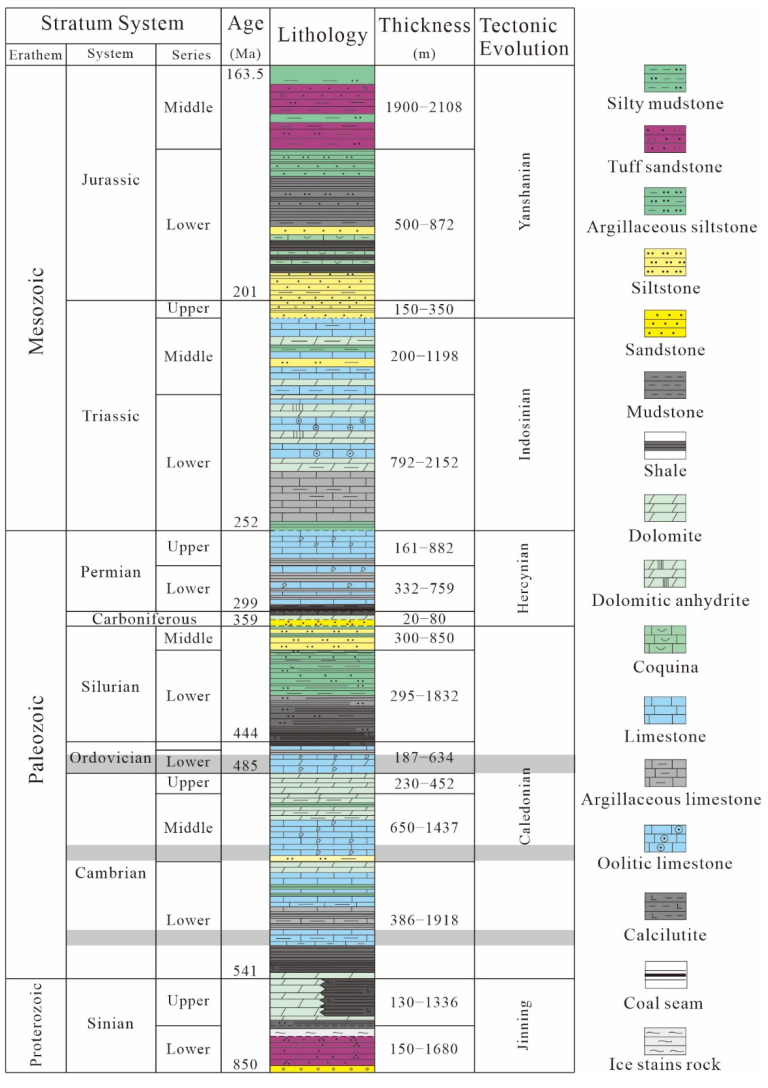
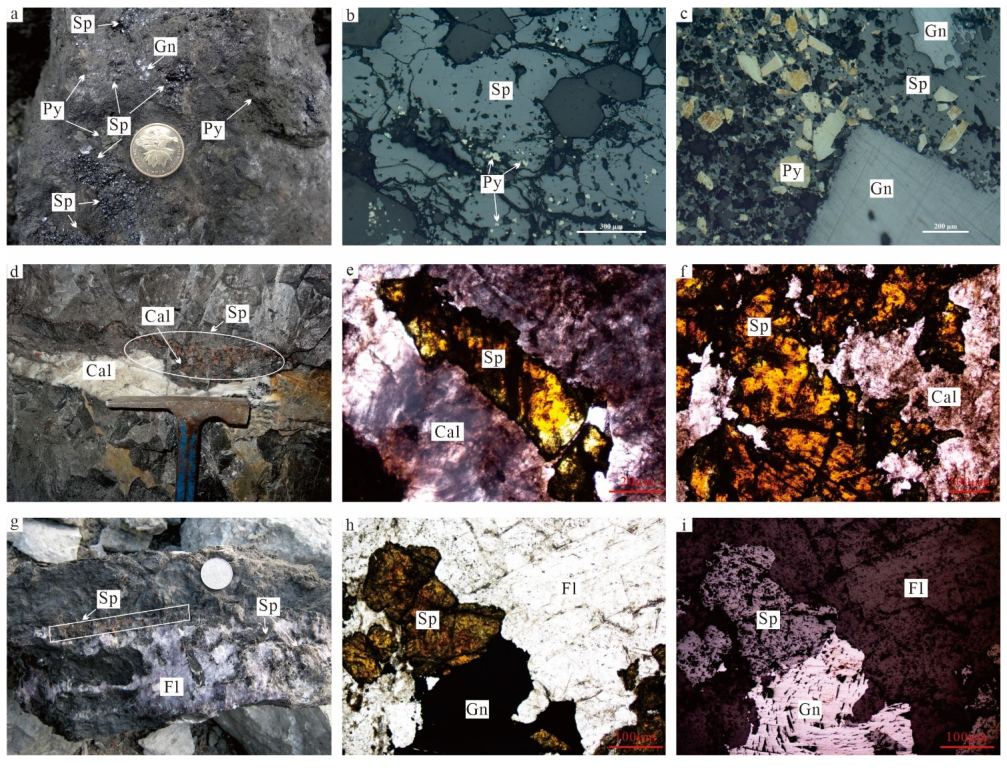

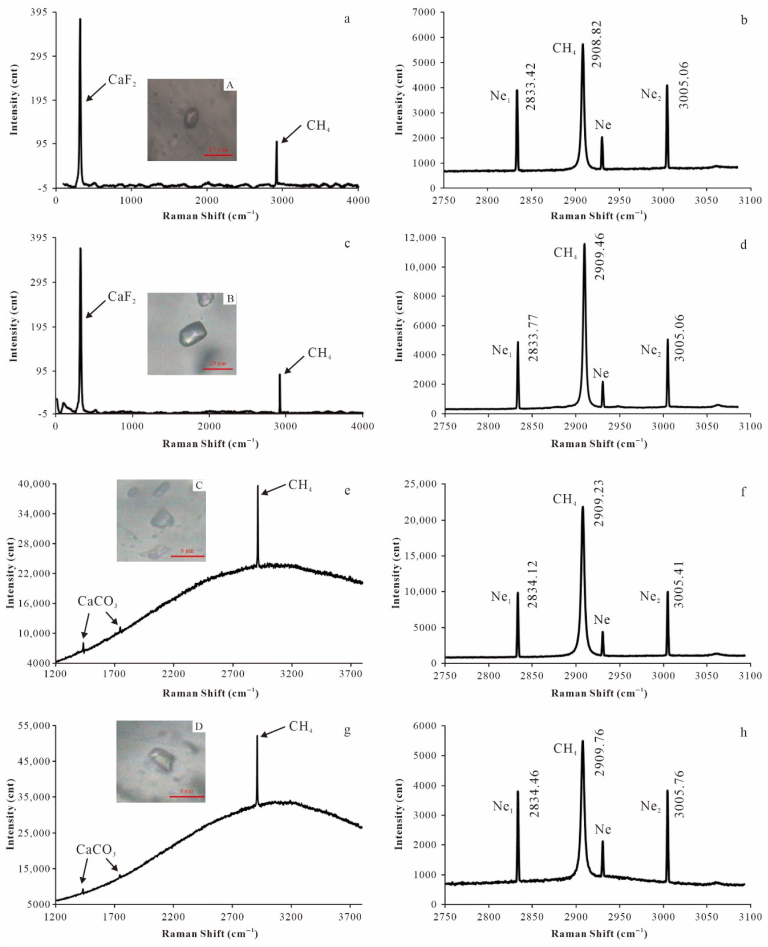


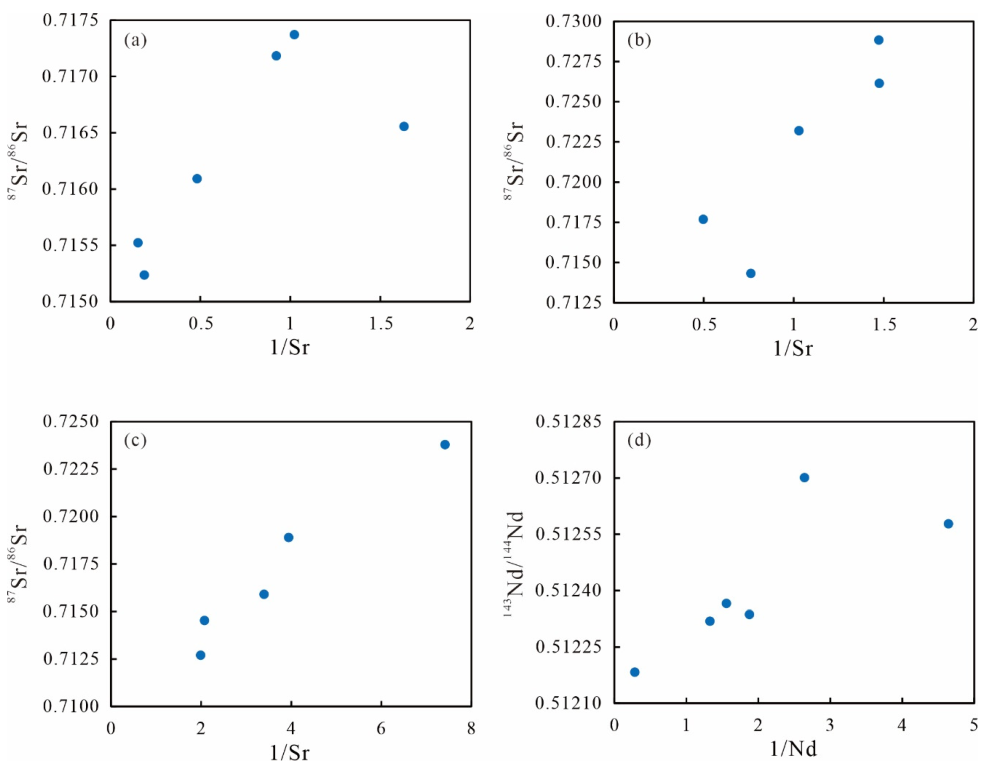
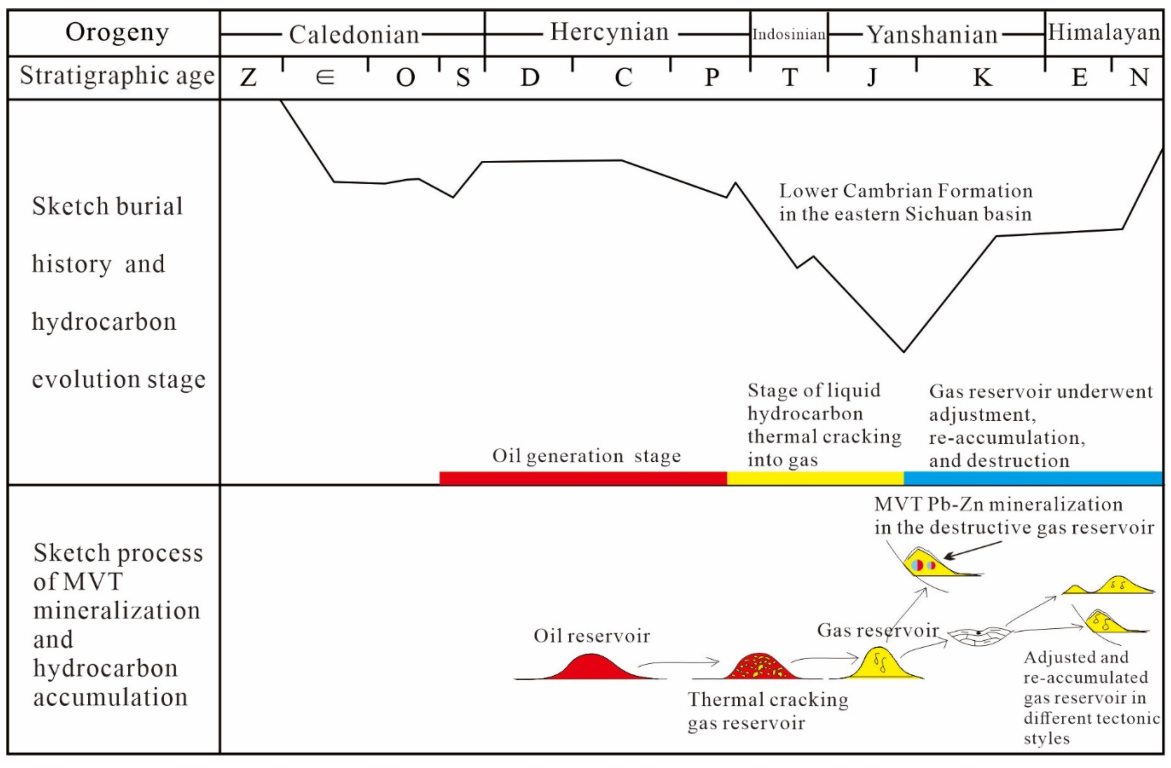
| Location | Pb-Zn Mine Name | Pb-Zn Orebody Name | Latitude (°N) | Longitude (°E) | Sample | Stratigraphy | Host Lithology | Dominant Mineralogy |
|---|---|---|---|---|---|---|---|---|
| Shizhu synclinorium | Laochangping | Liuhuangdong | 29°48′52.52″ | 108°15′7.80″ | SH1 | Lower Cambrian Qingxudong Formation | Dolomitic limestone | Sphalerite containing pyrite, galena and calcite |
| SH2 | Sphalerite containing pyrite and calcite | |||||||
| SH3 | Sphalerite containing pyrite and calcite | |||||||
| Wanbao | 29°54′15.91″ | 108°14′46.35″ | WB1 | Middle Cambrian Gaotai Formation | Sphalerite containing pyrite, galena and calcite | |||
| WB2 | Pyrite containing sphalerite | |||||||
| WB3 | Pyrite containing sphalerite | |||||||
| Yidu-Hefeng anticlinorium | Luota | Laoxi | 29°2′3.05″ | 109°43′38.50″ | LX1 | Lower Ordovician Nanjinguan Formation | Bioclastic limestone | Sphalerite containing galena and calcite |
| LX2 | Sphalerite containing galena and calcite | |||||||
| LX3 | Sphalerite containing calcite | |||||||
| LX4 | Sphalerite containing calcite | |||||||
| Wujiahe | 29°35′48.71″ | 110°4′29.05″ | SZ1 | Lower Ordovician Dawan Formation | Silicified limestone | Fluorite containing sphalerite and galena | ||
| SZ2 | Fluorite containing sphalerite | |||||||
| SZ3 | Fluorite containing sphalerite and galena | |||||||
| SZ4 | Fluorite containing sphalerite and calcite |
| Pb-Zn Mine Name | Pb-Zn Orebody Name | Sample Number | Mineral | Rb (μg/g) | Sr (μg/g) | 87Rb/86Sr | 87Sr/86Sr (2σ) |
|---|---|---|---|---|---|---|---|
| Laochangping | Liuhuangdong | SH1 | Sphalerite | 0.4897 | 2.078 | 0.6937 | 0.716091 ± 9 |
| SH1 | Pyrite | 0.5513 | 5.314 | 0.3061 | 0.715237 ± 12 | ||
| SH2 | Pyrite | 0.9382 | 6.503 | 0.4259 | 0.715523 ± 9 | ||
| SH2 | Sphalerite | 0.4451 | 0.9781 | 1.341 | 0.717372 ± 8 | ||
| SH2 | Sphalerite | 0.4509 | 1.885 | 1.237 | 0.717184 ± 11 | ||
| SH3 | Sphalerite | 0.1928 | 0.6127 | 0.9305 | 0.716557 ± 9 | ||
| Wanbao | WB1 | Sphalerite | 0.5632 | 1.314 | 1.268 | 0.714311 ± 8 | |
| WB1 | Pyrite | 1.874 | 0.9725 | 5.679 | 0.723193 ± 9 | ||
| WB2 | Pyrite | 1.931 | 0.6789 | 8.397 | 0.728832 ± 9 | ||
| WB2 | Pyrite | 1.639 | 0.6775 | 7.134 | 0.726145 ± 9 | ||
| WB3 | Pyrite | 2.015 | 2.013 | 2.945 | 0.717679 ± 9 | ||
| Luota | Laoxi | LX1 | Sphalerite | 0.1579 | 0.5031 | 0.921 | 0.712701 ± 8 |
| LX2 | Sphalerite | 0.2381 | 0.4817 | 1.842 | 0.714528 ± 6 | ||
| LX2 | Sphalerite | 0.2537 | 0.2946 | 2.537 | 0.715890 ± 10 | ||
| LX3 | Sphalerite | 0.2986 | 0.1349 | 6.539 | 0.723791 ± 8 | ||
| LX4 | Sphalerite | 0.3249 | 0.2537 | 4.108 | 0.718894 ± 8 |
| Pb-Zn Mine Name | Pb-Zn Orebody Name | Sample Number | Mineral | Sm (μg/g) | Nd (μg/g) | 147Sm/144Nd | 143Nd/144Nd (2σ) | 87Sr/86Sr (2σ) |
|---|---|---|---|---|---|---|---|---|
| Luota | Wujiahe | SZ1 | Fluorite | 0.3267 | 0.7521 | 0.2634 | 0.512319 ± 9 | 0.714058 ± 9 |
| SZ2 | Fluorite | 0.4092 | 0.3782 | 0.6547 | 0.512701 ± 8 | 0.714152 ± 8 | ||
| SZ3 | Fluorite | 0.3314 | 0.6421 | 0.3125 | 0.512366 ± 10 | 0.714227 ± 7 | ||
| SZ3 | Fluorite | 0.2507 | 0.5326 | 0.2846 | 0.512337 ± 9 | 0.713753 ± 9 | ||
| SZ4 | Fluorite | 0.1886 | 0.2154 | 0.5304 | 0.512578 ± 8 | 0.714749 ± 11 | ||
| SZ4 | Calcite | 0.7325 | 3.526 | 0.1159 | 0.512183 ± 10 | 0.713814 ± 6 |
Publisher’s Note: MDPI stays neutral with regard to jurisdictional claims in published maps and institutional affiliations. |
© 2022 by the authors. Licensee MDPI, Basel, Switzerland. This article is an open access article distributed under the terms and conditions of the Creative Commons Attribution (CC BY) license (https://creativecommons.org/licenses/by/4.0/).
Share and Cite
He, Z.; Gao, J.; Li, S.; He, S. Mineralization of MVT Pb-Zn Deposits in the Process of Hydrocarbon Accumulation and Destruction in the Strong Structural Deformation Area of Eastern Sichuan, South China. Minerals 2022, 12, 1281. https://doi.org/10.3390/min12101281
He Z, Gao J, Li S, He S. Mineralization of MVT Pb-Zn Deposits in the Process of Hydrocarbon Accumulation and Destruction in the Strong Structural Deformation Area of Eastern Sichuan, South China. Minerals. 2022; 12(10):1281. https://doi.org/10.3390/min12101281
Chicago/Turabian StyleHe, Zhiliang, Jian Gao, Shuangjian Li, and Sheng He. 2022. "Mineralization of MVT Pb-Zn Deposits in the Process of Hydrocarbon Accumulation and Destruction in the Strong Structural Deformation Area of Eastern Sichuan, South China" Minerals 12, no. 10: 1281. https://doi.org/10.3390/min12101281
APA StyleHe, Z., Gao, J., Li, S., & He, S. (2022). Mineralization of MVT Pb-Zn Deposits in the Process of Hydrocarbon Accumulation and Destruction in the Strong Structural Deformation Area of Eastern Sichuan, South China. Minerals, 12(10), 1281. https://doi.org/10.3390/min12101281





